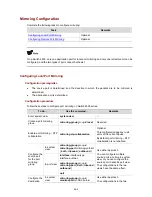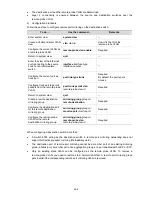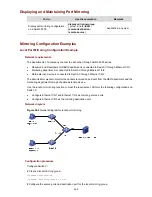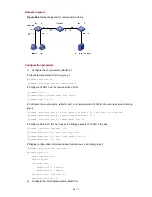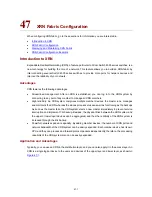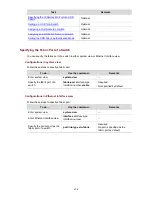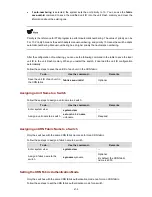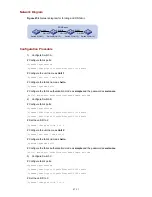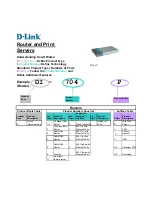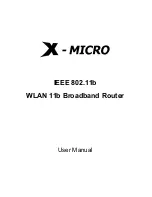
[Sysname] mirroring-group 1 mirroring-port Ethernet 1/0/1 Ethernet 1/0/2 both
[Sysname] mirroring-group 1 monitor-port Ethernet 1/0/3
# Display configuration information about local mirroring group 1.
[Sysname] display mirroring-group 1
mirroring-group 1:
type: local
status: active
mirroring port:
Ethernet1/0/1 both
Ethernet1/0/2 both
monitor port: Ethernet1/0/3
After the configurations, you can monitor all packets received on and sent from the R&D department
and the marketing department on the data detection device.
Remote Port Mirroring Configuration Example
Network requirements
The departments of a company connect to each other through Switch 4500 series:
z
Switch A, Switch B, and Switch C are Switch 4500 series.
z
Department 1 is connected to Ethernet 1/0/1 of Switch A.
z
Department 2 is connected to Ethernet 1/0/2 of Switch A.
z
Ethernet 1/0/3 of Switch A connects to Ethernet 1/0/1 of Switch B.
z
Ethernet 1/0/2 of Switch B connects to Ethernet 1/0/1 of Switch C.
z
The data detection device is connected to Ethernet 1/0/2 of Switch C.
The administrator wants to monitor the packets sent from Department 1 and 2 through the data
detection device.
Use the remote port mirroring function to meet the requirement. Perform the following configurations:
z
Use Switch A as the source switch, Switch B as the intermediate switch, and Switch C as the
destination switch.
z
On Switch A, create a remote source mirroring group, configure VLAN 10 as the remote-probe
VLAN, ports Ethernet 1/0/1 and Ethernet 1/0/2 as the source ports, and port Ethernet 1/0/4 as the
reflector port.
z
On Switch B, configure VLAN 10 as the remote-probe VLAN.
z
Configure Ethernet 1/0/3 of Switch A, Ethernet 1/0/1 and Ethernet 1/0/2 of Switch B, and Ethernet
1/0/1 of Switch C as trunk ports, allowing packets of VLAN 10 to pass.
z
On Switch C, create a remote destination mirroring group, configure VLAN 10 as the remote-probe
VLAN, and configure Ethernet 1/0/2 connected with the data detection device as the destination
port.
46-10









